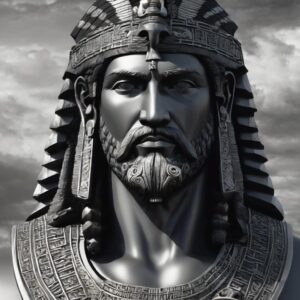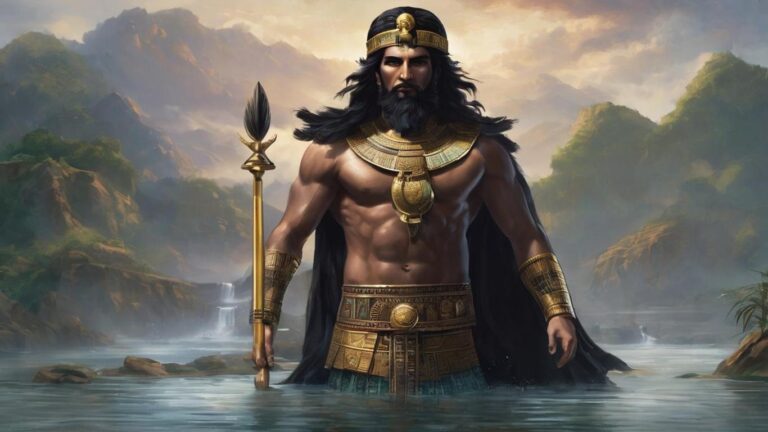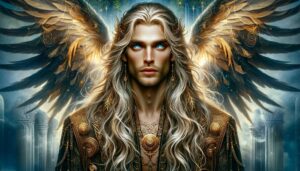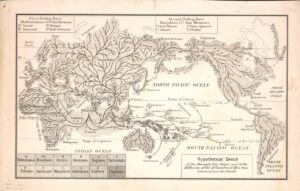Table of Contents
Enki, a god in Sumerian mythology, represents water, wisdom, magic, and creation. He holds a pivotal role in Sumerian creation myths. Enki, associated with freshwater, is contrasted with Apsu, symbolizing chaotic waters. Depictions often show streams from his shoulders, symbolizing the Tigris and Euphrates rivers.
Renowned for cleverness and wisdom, Enki benevolently aids humanity by imparting knowledge. The “Atrahasis Epic” underscores his pivotal role in creating humans and managing their population. In later Akkadian and Babylonian mythology, people recognize Enki as Ea. His worship extends beyond Sumer, reaching other cultures in the region, who adopt and adapt the associated mythology.
Appearance

Descriptions of the appearance of gods in ancient mythologies are often symbolic and metaphorical rather than literal. Depictions of Enki vary, and there is no single standardized representation. However, some common elements and symbols associated with Enki’s representations in art and literature include:
Streams of Water: Enki’s association with water is evident in artistic representations, which often depict streams of water flowing from his shoulders or portray him in a watery environment. This symbolism underscores his connection to the Abzu, the freshwater abyss from which he emerged.
Double-Helix Rod (Caduceus): Enki occasionally holds a double-helix rod in depictions, resembling the later Caduceus symbol. This symbolizes his affiliation with healing and magic.
Goat-Fish Hybrid: In certain representations, artists depict Enki as a deity with the lower body of a fish and the upper body of a goat. This hybrid creature serves as a symbol of his connection to both water (represented by the fish) and mountainous regions (symbolized by the goat).
Crown or Horned Hat: At times, artists portray Enki wearing a crown or a hat adorned with horns. This serves as a symbolic representation, signifying his divine status and authority.
It’s important to note that these representations are artistic interpretations, and the symbolic elements convey the attributes and domains associated with Enki rather than a realistic depiction of his physical appearance. The imagery is often rich in symbolism and cultural significance, reflecting the mythology and beliefs of the ancient Sumerians.
Legends and Stories

Enki is a prominent figure in Sumerian mythology, and various legends and stories revolve around this god of wisdom and water. Here are a few notable myths:
Creation of Humans:
In the “Atrahasis Epic,” Enki plays a crucial role in the creation of humanity. In response to the overpopulation of gods, Enki advises the god Enlil to create humans to relieve the gods from toiling. Enki then shapes the first humans from clay and blood.
The Theft of the Me:
In another myth, the disruption of order in the world concerns the gods. The goddess Inanna tricks Enki into giving her the “Me,” divine decrees or powers controlling various aspects of civilization. Enki regrets his decision, initiating a sequence of events to retrieve the Me.
The Great Flood:
Enki is also a central figure in the Sumerian version of the Great Flood story. In this narrative, he warns the hero Atrahasis about the impending flood, advising him to build a boat to save himself, animals, and craftsmen.
Inanna’s Descent:
Enki plays a prominent role in the myth of Inanna’s descent into the Underworld. When Inanna is trapped in the Underworld, Enki sends emissaries to rescue her, showcasing his role as a helpful and wise deity.
The Creation of the World:
Enki is associated with the organization of the cosmos. In some myths, he separates heaven and earth, playing a key role in establishing order and creating a suitable environment for life.
These myths highlight Enki’s multifaceted nature, depicting him as a god of creation, wisdom, and a mediator between gods and humanity. The stories also showcase his cleverness and benevolence, emphasizing his importance in Sumerian mythology.
Family

An (Anu in Akkadian), the god of the heavens, and Nammu, the primeval goddess of the sea, often describe Enki as their son. This makes him a significant deity within the divine pantheon. Enki’s siblings include Enlil, the god of wind and storm, and Ninhursag, a goddess associated with fertility and healing.
Ninhursag (Ninti): Enki’s sister and consort is Ninhursag, a prominent goddess associated with fertility, birth, and healing. Sumerian mythology frequently depicts Enki and Ninhursag as a divine couple.
Marduk (Bel): In Babylonian mythology, Marduk, at times considered a son of Enki, emerges as a significant god. He ascends to the position of the chief deity in the Babylonian pantheon, particularly prominent during the era of the Enuma Elish, the Babylonian creation epic.
Ninsar: Enki and Ninhursag have a daughter named Ninsar, featured in Sumerian myths. Her name, translating to “Lady Greenery,” reflects her connection to nature and fertility.
FAQ
Who killed Enki?
There is no mythological account of Enki being killed. In Sumerian mythology, he continues to play a prominent role, and there is no record of his death at the hands of another deity.
Who gave birth to Enki?
In Sumerian mythology, Enki is often considered the son of An (Anu in Akkadian), the god of the heavens, and Nammu, the primeval goddess of the sea.
Was Enki a Merman?
While Enki is sometimes associated with water and depicted with streams flowing from his shoulders, he is not typically described as a merman. In art, he is more commonly depicted with human and sometimes hybrid features.
Is Enki a good god?
Enki is generally portrayed as a benevolent god in Sumerian mythology. He is associated with wisdom, creation, and helping humanity. His character is often depicted favorably in the myths.
Did Enki get pregnant?
Yes, in the myth of "The Atrahasis Epic," Enki consumes forbidden plants and becomes pregnant. After giving birth to eight plants, he experiences pain and seeks relief from the goddess Ninhursag.




